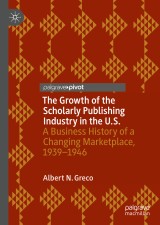Details

The Growth of the Scholarly Publishing Industry in the U.S.
A Business History of a Changing Marketplace, 1939-1946|
58,84 € |
|
| Verlag: | Palgrave Pivot |
| Format: | |
| Veröffentl.: | 16.10.2018 |
| ISBN/EAN: | 9783319995496 |
| Sprache: | englisch |
Dieses eBook enthält ein Wasserzeichen.
Beschreibungen
<p>This book analyzes the dynamic growth of the scholarly publishing industry in the United States during 1939-1946, a critical period in the business history of scholarly publications in STM and the humanities and the social sciences. It explains how the key publishing players positioned themselves to take advantage of the war economy and how they used different business and marketing strategies to create the market and demand for scholarly publications. Not only did the atomic threat necessitate a surge in scholarly research, but at the same time scholarly publishing managers prepared for the dramatic shift by anticipating the potential impact of the GI Bill on higher education, creating superb printed products, and by becoming the brand, the source of knowledge and information. The creation of strategic business units and value chains as well as the development of marketing targeting strategies resulted in brand loyalty to certain publishers and publications but also accelerated the growth of the US scholarly publishing industry. Business historians and marketing professors interested in the business strategies of scholarly publishers during World War II will find this book to be a valuable resource.<br></p>
<p></p><p>1 Introduction to Scholarly Journal and Book Publishing in the U.S. State of Scholarly Publishing Today</p><p>2 The Impact of the Depression and Nuclear Research on Universities, Research, and Scholarly Publishing: 1929–1941</p><p>3 The Impact of World War II on American Society and Scholarly Publishing: December 7, 1941–1942</p><p>4 The War and Its Impact on Research: 1943–1945<br></p><p>5 1946: A Turning Point in the Growth of Scholarly Publishing</p><p></p>
<b>Albert N. Greco</b> is Professor of Marketing at the Gabelli School of Business at Fordham University, USA. He has authored or edited 25 books, mostly in relation to the book and scholarly journal industries, though he has also written extensively on the newspaper, magazine, information, and radio sectors.
<p>This book analyzes the dynamic growth of the U.S. scholarly publishing industry in the United States during 1939-1946, a critical period in the business history of scholarly publications in STM and the humanities and the social sciences. It explains how the key publishing players positioned themselves to take advantage of the war economy and how they used different business and marketing strategies to create the market and demand for scholarly publications. Not only did the atomic threat necessitate a surge in scholarly research, but at the same time scholarly publishing managers prepared for the dramatic shift by anticipating the potential impact of the GI Bill on higher education, creating superb printed products, and by becoming the brand, the source of knowledge and information. The creation of strategic business units and value chains as well as the development of marketing targeting strategies resulted in brand loyalty to certain publishers and publications but also accelerated the growth of the US scholarly publishing industry. Business historians and marketing professors interested in the business strategies of scholarly publishers during World War II will find this book to be a valuable resource.</p>
<p>First analysis of the the growth of scholarly journal publications in the U.S</p><p>Examines how scholarly research and publications were shared within U.S. agencies/departments and to and from academic researchers in the U.K. and Canada</p><p>Explores the dramatic impact of the “Servicemen’s Readjustment Act of 1944” on higher education and the increased demand for scholarly publications for higher education classroom use, faculty members, and academic library collections</p>


















